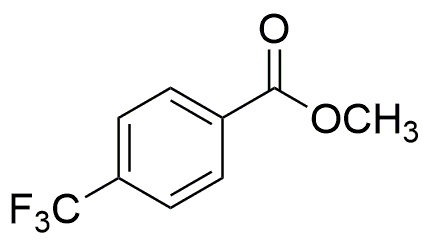Methyl 4-(trifluoromethyl)benzoate is widely utilized in research focused on:
- Pharmaceutical Development: This compound serves as an important intermediate in the synthesis of various pharmaceuticals, particularly those targeting specific biological pathways due to its unique trifluoromethyl group, which enhances biological activity.
- Agricultural Chemicals: It is used in the formulation of agrochemicals, including herbicides and insecticides, where its properties help improve efficacy and selectivity, making it valuable for crop protection.
- Material Science: Methyl 4-(trifluoromethyl)benzoate is employed in the development of advanced materials, particularly in creating polymers with enhanced thermal and chemical resistance, which are essential in various industrial applications.
- Fluorinated Compounds Research: Researchers utilize this compound to study the effects of fluorination on chemical reactivity and stability, providing insights that can lead to the development of new materials and chemicals.
- Cosmetic Formulations: It is also incorporated into cosmetic products for its ability to improve texture and stability, making it an attractive option for formulators looking to enhance product performance.
General Information
Properties
Safety and Regulations
Applications
Methyl 4-(trifluoromethyl)benzoate is widely utilized in research focused on:
- Pharmaceutical Development: This compound serves as an important intermediate in the synthesis of various pharmaceuticals, particularly those targeting specific biological pathways due to its unique trifluoromethyl group, which enhances biological activity.
- Agricultural Chemicals: It is used in the formulation of agrochemicals, including herbicides and insecticides, where its properties help improve efficacy and selectivity, making it valuable for crop protection.
- Material Science: Methyl 4-(trifluoromethyl)benzoate is employed in the development of advanced materials, particularly in creating polymers with enhanced thermal and chemical resistance, which are essential in various industrial applications.
- Fluorinated Compounds Research: Researchers utilize this compound to study the effects of fluorination on chemical reactivity and stability, providing insights that can lead to the development of new materials and chemicals.
- Cosmetic Formulations: It is also incorporated into cosmetic products for its ability to improve texture and stability, making it an attractive option for formulators looking to enhance product performance.
Documents
Safety Data Sheets (SDS)
The SDS provides comprehensive safety information on handling, storage, and disposal of the product.
Product Specification (PS)
The PS provides a comprehensive breakdown of the product’s properties, including chemical composition, physical state, purity, and storage requirements. It also details acceptable quality ranges and the product's intended applications.
Certificates of Analysis (COA)
Search for Certificates of Analysis (COA) by entering the products Lot Number. Lot and Batch Numbers can be found on a product’s label following the words ‘Lot’ or ‘Batch’.
*Catalog Number
*Lot Number
Certificates Of Origin (COO)
This COO confirms the country where the product was manufactured, and also details the materials and components used in it and whether it is derived from natural, synthetic, or other specific sources. This certificate may be required for customs, trade, and regulatory compliance.
*Catalog Number
*Lot Number
Safety Data Sheets (SDS)
The SDS provides comprehensive safety information on handling, storage, and disposal of the product.
DownloadProduct Specification (PS)
The PS provides a comprehensive breakdown of the product’s properties, including chemical composition, physical state, purity, and storage requirements. It also details acceptable quality ranges and the product's intended applications.
DownloadCertificates of Analysis (COA)
Search for Certificates of Analysis (COA) by entering the products Lot Number. Lot and Batch Numbers can be found on a product’s label following the words ‘Lot’ or ‘Batch’.
*Catalog Number
*Lot Number
Certificates Of Origin (COO)
This COO confirms the country where the product was manufactured, and also details the materials and components used in it and whether it is derived from natural, synthetic, or other specific sources. This certificate may be required for customs, trade, and regulatory compliance.


